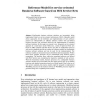1981 search results - page 384 / 397 » Model-Checking Hierarchical Structures |
AAAI
2010
13 years 9 months ago
2010
Multi-Agent Plan Recognition (MAPR) seeks to identify the dynamic team structures and team behaviors from the observations of the activity-sequences of a set of intelligent agents...
EDM
2008
13 years 9 months ago
2008
Using data from an existing pre-algebra computer-based tutor, we analyzed the covariance of item-types with the goal of describing a more effective way to assign skill labels to it...
LREC
2008
13 years 9 months ago
2008
After a long history of compilation of our own lexical resources, EDR Japanese/English Electronic Dictionary, and discussions with major players on development of various WordNets...
SIGSAND
2008
13 years 9 months ago
2008
Configurable business software solutions are increasingly being implemented based on service oriented architectures (SOA). Hereunto model driven approaches for the definition and i...
AAAI
2006
13 years 9 months ago
2006
Voting (or rank aggregation) is a general method for aggregating the preferences of multiple agents. One important voting rule is the Slater rule. It selects a ranking of the alte...

